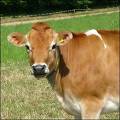 Harriet the Jersey cow had 22 Officers out to kill her.
Harriet the Jersey cow had 22 Officers out to kill her. .
.
by Christoper Booker
I have reported many strange confrontations between officialdom and the British public over the years, but none more bizarre than the drama which unfolded 10 days ago in a field near Newent in the Forest of Dean. At 10.30 on the morning of 10 January no fewer than 22 officials – two state veterinary officials and eight trading standards officials, supported by 12 policemen – turned up, without warning, to slaughter Harriet, a perfectly healthy, nine-year-old pet Jersey cow.
.
Last week, more details emerged of this latest twist to a barely credible story which has been unfolding for many months and was raised in Parliament last November by the local MP, Mark Harper. The Department for Environment, Food and Rural Affairs is determined to kill Harriet (known to Defra as "bovine animal UK OX0564 00177") because another calf, born five months later, belonging to a different herd on another part of the same Oxfordshire farm, eventually developed BSE. Under the EU rules which were drawn up as part of ending the British beef ban, Harriet would have to be destroyed as a "cohort" of the infected animal, because she had been born within a year on the same farm.
.
In vain did Harriet's owner, David Price, point out that the two animals had never met and could never have shared the same food, and that the EU directive only applied to animals intended for the food chain. When this was raised in the Commons by Mr Harper on November 7, the agriculture minister, Ben Bradshaw, ritually intoned that there was "no exemption under EU or domestic law for live cattle, whether or not they are considered to be pets". If Defra allowed Harriet to live, Brussels would sue.
.
A fortnight later, however, a message came from an official in the European Parliament to say that, from the end of this month, a new EU regulation will mean that an animal need not be destroyed until it reaches the end of its "productive life" (which, for Harriet, would mean when she dies of natural causes). The message ended: "I hope this helps. All the best for you and Harriet."
.
Perhaps this was why Defra sent in its hit-squad. On 10 January at 9.20 am, Mr Price had a tip-off that they would be there within the hour. At 10.30 he and a small group of supporters were astonished to see a body of police blocking the road, while officials took a bolt-cutter to the chained gate of Harriet's field. (This, they said, was quite within their powers under the new Animal Health Act.) They planned to invade the field, corner Harriet, and haul her off to be killed and incinerated.
.
A stand-off ensued, lasting four hours, with much mobile telephoning on both sides. The local vicar, the Rev Patricia Pinkerton, having asked someone else to take a service, arrived to say that Mr Price's lawyers were applying for an emergency injunction, forbidding Defra to take any further action until the case was judicially reviewed.
.
Eventually Mr Price's solicitor herself marched sternly up the muddy lane in her smart suit and high-heeled shoes, clutching papers to confirm that the injunction process had begun. The yellow-jacketed officials departed in their fleet of vehicles, leaving Pat Innocent, the observer on whose evidence this account is based, to muse on the famous 1960s experiments by Stanley Milgram showing how easily people can be persuaded by authority to obey foolish orders which result in inflicting unnecessary pain on others.















No comments:
Post a Comment